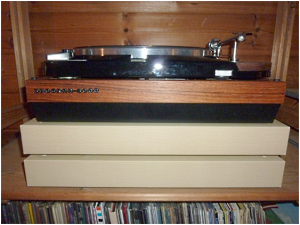Classic Audio
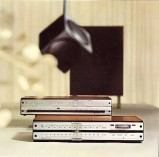
BLOG
Beomaster 4400 is known by most B&O enthusiasts. It is a beautiful product that plays absolutely fantastic and is rated as one of the best amplifiers B&O has produced.
Beomaster 4401
Not many people know this product. In fact, only 3 copies have been found so far, but more may exist.
The Beomaster 4401 is almost identical to the Beomaster 4400, but there is one major difference, and that is the front panel. On the Beomaster 4401, the front panel is black anodized.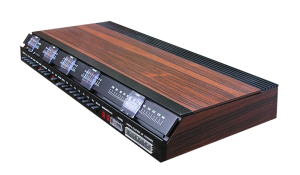
It is a very nice product.
A case in rosewood and front panels in black anodized aluminum – it goes together fantastically well.
Another small difference is of course the product type, which shows that B&O has at some point considered putting it on the market.
All 3 known Beomaster 4401 are marked with B&O prototype identification (Red label with product number).
Beomaster 4401 front panel with product type ID
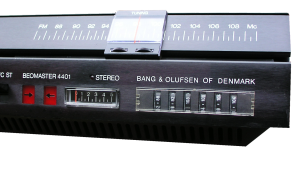
It is very interesting if there are more existing Beomaster 4401.
If you own a Beomaster 4401 or know someone who has the product, I would really like an email with a picture of the Beomaster 4401 and a picture of the product number on the back of the device.
When you have chosen your classic HiFi amplifier, the one you have dreamed of for many years or you have had your own classic product completely renovated, you come to an important point
Choosing the best speaker for the amplifier.
There are a whole range of factors to take into account in connection with the choice.
What size speaker is there room for in the room where the system is to be placed?
Are there already preferences for a particular speaker selection?
With these points in mind, there is still a very important technical point, and in that context it is essential to make a choice so that an optimal match is achieved technically between amplifier and loudspeaker.
There are many who expect that the choice of a newer speaker for a classic amplifier will really be a good choice based on the fact that a newer speaker must be technologically much better than classic speakers produced many years ago and where newer technology was not known or possible.
There are also owners of classic products who want to try several different speaker / amplifier combinations in order to achieve the absolutely fantastic sound. It is a very time-consuming and often very expensive way of solving the problem, and it is rare to achieve a really good result.
For me, it is absolutely clear that the most optimal solution is to choose the speakers the manufacturer has developed especially for your classic HiFi amplifier.
Why that?
For e.g. B&O then means the development of a HiFi system at the same time as the development of all the units included in the system before launch. This means that many engineering hours have been spent on matching the amplifier and speakers for the absolute optimum sound.
Development of a HiFi system typically takes around 3 years at B&O. (It has been normal for the 25 years I have worked at B&O), that is why I have difficulty seeing that today we can do better.
Therefore, my suggestion would ALWAYS be to choose amplifier and speakers that were launched together, that are part of the same system, and thus are from the same time period.
In light of these facts, it would be a good idea for us to discuss the choice of speaker at the same time as agreements to purchase a totally refurbished classic HiFi amplifier or agreements to renovate your amplifier, where you may not have the optimal speaker solution right now.
In order to get the most out of a classic amplifier that has just been completely renovated, a set of speakers that have been developed for this particular amplifier will surely provide the most optimal system with a fantastically beautiful classic sound.
…an example
For the Beolab 5000, the right speaker is the BEOVOX 5000 with the BEOVOX 2500 CUBE
Alternatively, you can choose BEOVOX 3000 with BEOVOX 2500 CUBE if there are space problems.
…another example
For the Beomaster 1000, the right speaker is the BEOVOX 1000
Classic Audio offers refurbishment of your B&O pickup.
Suspension, needle tube and diamond can be changed. This means that a pickup will be like new again. It is actually also possible to choose a better grinding of the diamond and thereby upgrade your pickup.
There are the following cuts of a diamond:
- Spherical diamond
- Elliptical diamond
- Ren (Nude-Line) diamant
- Pure (Nude-Line) elliptical diamond
- Original Shibata diamant
Classic Audio always supplies a pickup that is refurbished (re-tipped) with all turntable orders.
Each and every pickup is tested individually, and it is a fairly extensive and time-consuming test. The test is carried out because it is essential to ensure that Classic Audio’s requirements for quality are met. The test results are the basis for the certificate that comes with every pickup Classic Audio sells together with turntables.
Here is an example of a test result
Classic Audio Certificate
Classic Audio also offers this comprehensive quality test of your pickup.
Contact Classic Audio for more information and a quote.
I recently found a Beolab 5000, it’s not that unusual, but this Beolab 5000 was special.
The owner had bought it new in 1968 together with Beomaster 5000.
Here is the purchase note for Beolab 5000!
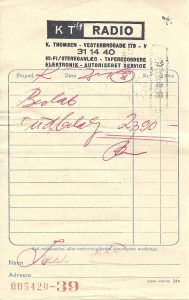
The price at the time was DKK 2,350 – the equivalent of DKK 19,000 today. (ref. Denmark’s Statistics price index). The owner was a postman – it has been a lot of money for him, and he also bought Beomaster 5000, it was a total purchase of more than DKK 30,000.
Beolab 5000 is in a very nice condition.
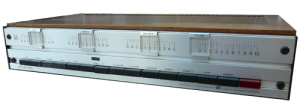
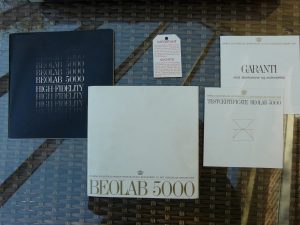
The owner had saved the user manual, brochure and warranty certificate that were delivered with the Beolab 5000 and it was in a very nice condition.
B&O’s test certificate for the Beolab 5000 was of course also saved. It is somewhat interesting to test this Beolab 5000 now and compare with the specifications B&O achieved more than 40 years ago. It is possible because a Beolab 5000 can actually play and plays reasonably well – yet!
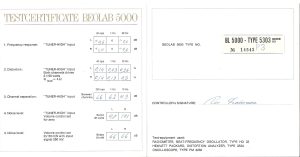

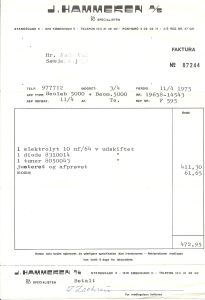 There has clearly been a degradation of the specifications and thus a deterioration of the sound quality.
There has clearly been a degradation of the specifications and thus a deterioration of the sound quality.
See the two certificates. Classic Audio today measures exactly the same points for all Beolab 5000s that are being completely refurbished as B&O did in 1968.
But the degraded measurement results for this Beolab are impressively good considering that this Beolab has ONLY been in for repair the 1st time , since it was purchased in 1968.
NOTE
A total refurbishment of this Beolab 5000 means that the specifications will be the same as the original B&O specifications (see the certificate above) or better, and the fantastic Beolab 5000 sound will once again be enjoyed.
Read a lot more about Beolab 5000 click here.

a post from one of Classic Audio’s customers: Paw Møller Pedersen – owner of a nice Beolab 5000 system with Beogram 3000 – Thorens TD 124 MKII
Life should ideally be easy
Modern people demand that things be easy. Easy to understand, easy to access and easy to get complete control over.
With every challenge, and here we think of the completely unmanageable challenges and the feeling of powerlessness that quickly arises when you cannot find the information you are looking for, via the indispensable internet, and in record time, and probably by skimming the texts in less than 10 seconds, can see through what has taken generations to deal with.
No, life is not always easy – in fact, from time to time, it can be difficult and very demanding. Therefore, it requires a painstaking acquisition of knowledge, a good deal of experience and a great deal of patience in order to succeed.
And it takes time!
A gramophone has a soul.
It is the same with a gramophone. It requires a certain knowledge, some experience and a lot of patience to be able to make it work optimally. It is not necessarily easy because, as with other things in life, it requires effort. But fortunately, the reward for those who make the effort comes in the form of a sound experience based on fantastic musicality and swing that is not surpassed by other electronic devices. In fact, one might feel that a gramophone in many ways does not seem at all related to other electrical products, but rather belongs in a completely different category. It is more closely related to musical instruments and, like a good old violin or guitar, it has both soul and personality, and living your life with one can be demanding, but also wonderfully charming and wonderfully rewarding.
Analog or digital
To this one can then ask: If the gramophone is demanding and difficult to get to play optimally, can’t a CD player or a streaming service be used instead and provide an equally magnificent musical experience? Yes, I’ve had many good CD players over the years. They have been great music players and easy to live with. In fact, for the most part, they have functioned almost problem-free in everyday life, and you have even gotten rid of the annoying crunch and noise from the vinyl record. Easier still are streaming services. Suddenly you have all the music you could want and are thus not limited to choosing from your own sparse music library. But the danger is that you can easily become overwhelmed, and a bit paralyzed, in the choice of music. There is so much and what should you choose? And at the same time, the challenge is that you instead end up searching, and searching again, just out of bewilderment at the enormous selection and thus don’t really get to immerse yourself in the music, because you’re not fully present, and the musical experience evaporates.
The sound from CD is good! Good players can actually reach a sublime level and with the new streaming service, Wimphifi, this medium has also become quite good. Beware of just connecting a computer or tablet/smartphone via the headphone output’s minijack connector – it sounds far from optimal. If it is an Apple product, you can either use dock or Airport, but even these solutions (although it is a better solution) sound boring, uninspiring, flat and the full potential is not utilized. But with the connection of an external dac, something really happens. The sound quality is significantly improved and even an otherwise reasonable CD player can suddenly sing again if it is paired with a quality DAC.
Therefore, the old trench warfare must not be torn up here either: Analogue (gramophone) vs. Digital (CD etc.). It is not an either or but a both and. It has never made sense to play the two media against each other. They both possess many good sound qualities and the true music lover, he/she who focuses on the essentials – namely the music, will always get a great and wonderful musical experience from both the one and the other media.
Placement and decoupling
But to return to my starting point, a gramophone therefore requires a bit of work to sound optimally. Gramophones must, among other things, placed appropriately to perform optimally and it is this area that I will touch on a little here. The other areas can then be mentioned another good time. As you know, there are both gramophone models which are based on a floating suspension and models which are based on a fixed suspension. And although the latter in particular needs to be placed with care, both constructions benefit greatly from being placed on a suitable surface. It is most advantageous to place it on a suitable shelf which is firmly attached to the wall. Thereby, it is completely decoupled from all the vibrations that relentlessly propagate from the floor.
A pickup signal is many, many times weaker than the signal from, for example, a CD player and therefore it must be amplified much more powerfully in order to achieve a sufficient sound level. The problem is simply that this process also amplifies several other unwelcome things – such as vibrations from the floor. There are divided opinions about which material the shelf in question should consist of. Some prefer a hard material such as MDF board or glass, perhaps with a tile on top, others lean more towards lighter almost hollow materials. The gramophone manufacturers also have the same approach to what material the turntable should be made in or out of and whether or not a damping mat should be on and in what material this should also be made in or out of.
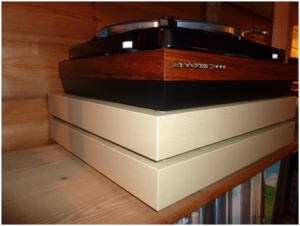
Personally, I have placed my Beogram 3000 on a bookcase shelf. This particular gramophone is very critical in terms of placement and therefore a good wall shelf placement should be the ideal solution. Unfortunately for me, the problem is that I live in a wooden house and that a wall shelf is not stable enough. It rocks, even though the vibrations from the floor are considerably reduced.
To overcome the unfortunate consequences, I have placed two records under the gramophone. They are bought at IKEA and are usually intended as the top and bottom of a small bookcase. The plates are light, they are close to being hollow, with a kind of cardboard construction in between. I have been referred these records by a recognized Copenhagen hi-fi store, as they are said to have a good decoupling effect. You can actually also use them with advantage to improve your listening room by mounting them around the walls and ceiling in order to achieve better acoustics.
Between these two plates and also against the bookshelf I have placed a total of 13 SD feet. These are small, round foam balls of approx. two cm. height. Unlike spikes, the SD feet provide a much better decoupling. You can get them in different degrees of hardness. Under the bottom plate, against the bookshelf, I use 8 pcs. of the brown version. Between the two plates I have then placed 5 pcs. of the green version. It is a slightly softer version, where one is slightly larger in diameter than the other 4 and which can then be placed as needed – primarily on the side where the power supply is located.
The result is that the gramophone goes from being a bit lusty-sounding with a tendency towards nasal voices to a more holistic reproduction, where everything hangs together better. The bass is better defined, the sound image has become more open and the sound more ear-friendly and harmonious. In short, there is simply less listening fatigue! In addition, the unwelcome sounds from the inevitable scratches are reduced.
Ending or a new beginning?
So it pays to spend a little/a lot of time setting up your gramophone. It is demanding, sometimes tending to the annoying – but after all the efforts you will (hopefully) arrive at your hifi paradise. It is not necessarily easy to get there, but the reward is rich.
And after you have enjoyed your efforts for a good while – heard a few of your favorite records (and now they sound better than before) you can then start thinking about where you need to put in to improve things – because there Are there always other parts/areas that could use an upgrade? Maybe you should look at the amplifier or the speakers or the cables or …. Well, once the hi-fi bacillus has taken up permanent residence in one, it never stops completely. You can always change something or try something new!
Have fun and good (vinyl) sound!
